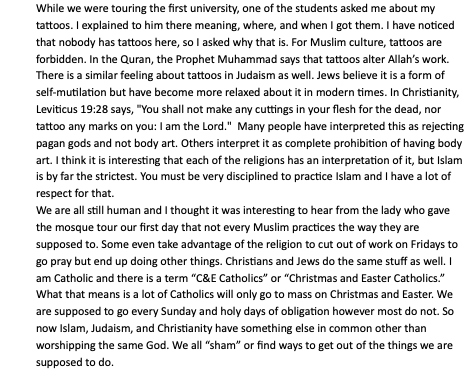Social Mobility in Morocco (Blogger #3: Ability or Social Status)
Just as everywhere else in the world, wealth is directly linked to quality of life in Morocco. There also exists great distances between the rich and the poor of Morocco, commonly referred to as a “wealth gap.” In Morocco, the wealth gap is exacerbated by a mix of social, cultural, and legal factors. Socially, there exists a disconnect between rural and urbanized areas. Those in rural regions often lack access to education, healthcare, and other government services, further restricting opportunities for social mobility. Culturally, societal norms and gender roles can limit women’s access to job opportunities. In 2023, labor force participation among Moroccan women over the age of 15 was reported at 19.8%, compared to 68.3% of Moroccan men 15 or older (ILO, 2024). Whether this be from familial expectations to become a homemaker or lack of positions available, the fact remains that only 1 in 5 Moroccan women receive a paycheck, and therefore have financial independence. While strides have been made in women’s rights, the data shows there is room for improvement in women’s opportunities. Overall, some action has been taken in Morocco’s legal system to address this issue. One example is social protection law No. 09.21, enacted in 2021, aimed to enhance social power in Morocco by expanding government healthcare and insurance, as access to healthcare has been shown to improve quality of life, increased GDP, and labor market function (White House Archives). However, the results of this law have been so far inconsistent due to lack of adequate healthcare in rural areas (Mansour & Benmouro, 2023).
I imagine that trying to close the wealth gap on a nationwide scale is one of the most complex tasks one can hope to achieve. This is because a wealth gap significantly impedes social mobility. Economic disparities mean that those from lower-income backgrounds often lack access to quality education, healthcare, and other resources essential for upward mobility. Limited financial resources furthers restrict opportunities for higher education and professional advancement, therefore reinforcing cycles of poverty. Additionally, social and cultural barriers, such as gender norms and regional inequalities, further constrain individuals' ability to improve their socioeconomic status. As a result, the wealth gap perpetuates inequality, making it challenging for individuals to break free from their socio-economic constraints.
Sources
International Labour Organization. “ILO Modelled Estimates and Projections database (ILOEST)” ILOSTAT. 2024. https://ilostat.ilo.org/data/
Mansour, H. A., & Benmouro, Y. (2023). Social protection reform in Morocco in the aftermath of COVID-19. Global social policy, 23(2), 348–351. https://doi.org/10.1177/14680181231180517
National Archives and Records Administration. (n.d.). The economic case for Health Care Reform. National Archives and Records Administration. https://obamawhitehouse.archives.gov/administration/eop/cea/TheEconomicCaseforHealthCareReform/#:~:text=Increased%20insurance%20coverage%20and%2C%20hence,functioning%20of%20the%20labor%20market

Comments
Post a Comment